Content
It is not uncommon for farmers who raise pigs and piglets to notice that strange dark, almost black scabs appear on the skin of animals, which tend to grow over time. What does such a black crust on the back of a piglet mean and how to treat it, you can learn in detail from the article.
Why pigs and piglets scratch
If the breeder is faced with a situation where the piglets are continuously scratching, then most likely, he or she will quickly come to the conclusion about the onset of the disease and try to treat the ailment at home. Efficiency in the treatment of any disease is never superfluous, but first it is worth determining what exactly will have to be dealt with. Intense itching in animals can have many causes, but it is most likely to be infected with a skin condition.
Skin diseases of piglets and pigs
Pigs are prone to a wide range of skin conditions. Some of them mainly affect young individuals, other diseases affect both piglets and adult animals equally. Among the most common diseases, it is worth noting:
- scabies;
- dermatitis;
- furunculosis;
- ringworm;
- erysipelas;
- vesicular disease.
Most skin diseases have similar symptoms, which is why even experienced breeders are often mistaken in the diagnosis. It should be remembered that only a veterinarian can accurately recognize the disease after conducting appropriate research.
Scabies in piglets and pigs
Scabies, also known as scab or sarcoptic mange, is a disease that causes a specific type of mite that lives under the skin of pigs and piglets, as shown. These parasites can settle on any part of the animal's body, but most often affect the areas around the eyes, nose or ears, where the skin is thinnest and most delicate.
There are several types of scabies:
- ear scabies, in which mites affect only the ears of piglets;
- total scabies, when parasites spread throughout the body of the animal.
Symptoms, diagnosis
The first signs of scabies in piglets can be recognized even before the symptoms appear: the animals experience severe itching and itch intensely, sometimes tearing the skin to blood, as in the photo. At the site of the most extensive scabies damage, the epidermis begins to peel off and grow overgrown with scabs.
Other symptoms of scabies in piglets include:
- the appearance of off-white crusts on the affected areas, as shown in the photo above;
- redness on the snout and near the ears;
- the presence of paired points on the skin of piglets, similar to insect bites;
- anxiety and aggressive behavior of animals due to itching.
If scabies is left untreated at this stage, mites will spread throughout the body, affecting the sides, limbs and back. The skin will become thicker and rougher, and the crusts will take on a dark brown, almost black hue. Severe cases of scabies provoke anemia and severe weakness in piglets.
At this point, it is especially important to diagnose scabies as soon as possible. Any delay in treatment can lead to the death of the animal.
The diagnosis is made by a qualified veterinarian based on characteristic clinical symptoms and laboratory findings. To carry out analyzes for the detection of scabies, skin scrapings from the auricles of piglets are necessary, moreover, samples must be taken from at least 10% of the livestock. If the causative agents of scabies could not be found, the examination should be repeated after 3 to 4 weeks.
How to treat scabies in piglets and pigs
Scabies can be treated in various ways: both traditional and folk. Medical treatment for scabies involves the use of a variety of ointments, aerosols, and tick injections. The latter is considered the most effective.
Against scabies, drugs such as Doramectin and Ivermectin, which are injected under the skin of the animal at the rate of 0.3 ml per 1 kg of the pig's body weight, have proven themselves especially well.
Drugs for external use have shown no less efficiency in the treatment of scabies, such as:
- Fosmet;
- Amitraz;
- Creolin;
- Ectosinol.
On their basis, a solution is prepared, referring to the instructions, after which the scab is treated in piglets 2 times with an interval of 10 days.
Often, livestock breeders practice the treatment of scabies in pigs and piglets with folk remedies. The most popular of these is a composition based on sour cream with gunpowder:
- Sour cream and gunpowder are mixed in a 3: 1 ratio.
- The resulting mixture is left to infuse for 3 hours.
- The finished composition treats the affected areas.
In addition to this method, the treatment of scabies in piglets is carried out with the help of other folk remedies, for example:
- ointment from wild rosemary and hellebore roots;
- a mixture of laundry soap, onions and garlic;
Proven benefits in the treatment of scabies and garlic oil tincture:
- Combine 100 g of minced garlic with 0.5 l of mustard oil and bring to a boil.
- Then the fire is removed and the composition is languished for another 20 minutes.
- Then the mixture is cooled, filtered, the garlic is squeezed.
- The finished product is used to treat the skin of pigs.
Dermatitis
Unlike scabies, dermatitis is not contagious. It occurs when a pig or piglet accidentally injures the skin and an infection enters the wound. It also causes the inflammatory process. Pigs of any age can get dermatitis.
The symptoms of this disease vary, depending on the cause, the severity of the injury, and the immunity of the piglet. As a rule, the affected area loses hair and turns red, and the wound is covered with scabs, under which the processes of tissue regeneration are activated. Touching the affected area gives the piglet unpleasant sensations.
If the animal's body cannot cope with the infection, the wound becomes an ulcer, pus is released from it, and necrosis may occur in advanced cases.
Mild forms of the disease are treated with ointments and antiseptic lotions, which disinfect wounds and relieve inflammation. If necrosis begins in a pig or piglet, the affected tissue is surgically removed.
Furunculosis
The appearance of single ulcers on the body of piglets can be triggered by various staphylococcal bacteria. In case of injury or other damage, they enter the hair follicle and contribute to its inflammation, resulting in the formation of a boil. Furunculosis also occurs due to a lack of vitamins in the animal's diet or due to poor hygiene.
Often, the disease is treated by rubbing the affected skin with iodine, brilliant green or salicylic alcohol.To relieve inflammation in the treatment, lotions with ichthyol ointment or paraffin are used.
If the boil is too large and causes severe pain to the pig, veterinary intervention may be required in addition to normal treatment. He will give the animal an injection of novocaine, cleanse the neoplasm from pus and disinfect the wound. Usually, the pig is then given a course of antibiotics.
Ringworm
Another reason why piglets itch may be ringworm. This skin disease occurs as a result of infection of pigs and piglets with a fungal infection through infected household items or as a result of contact with other animals. As a rule, piglets up to 6 - 8 months of age are most susceptible to the disease. Their immunity at this age is still not sufficiently strong, and therefore, they are much more sensitive to the effects of pathogens.
Piglets infected with ringworm show the following symptoms:
- oval or diamond-shaped spots appear on the surface of the body;
- the skin in the foci of irritation thickens and flakes;
- animals experience severe itching and scratch the affected area until scabs form.
Pigs should be treated for this disease by ensuring that infected individuals are isolated from healthy ones. For preventive purposes, the latter should vaccinate piglets against lichen.
As a treatment, the skin of sick animals is recommended to be treated with antifungal ointments or solutions. Various suspensions, which are intended for internal use, are very effective in treating the disease. Among them it is worth mentioning:
- Griseofulvin;
- Ketoconazole;
- Itraconazole.
Erysipelas
Discoloration of the skin and the appearance of a crust on the back in piglets can be signs of erysipelas. Erysipelas is a dangerous infectious disease for both pigs and humans. The first symptoms of the disease begin to appear after 7 to 8 days. Signs of acute inflammation include:
- a sharp increase in the temperature of the animal up to 42 ° C;
- loss of appetite;
- numbness of the limbs of the pig, because of which he refuses to move;
- disruption of the gastrointestinal tract;
- redness or blue discoloration of the skin in the abdomen and neck.
This form of the disease is considered the most dangerous for animals, as it develops rapidly and, in the absence of timely treatment, can provoke the death of pigs.
A chronic form of the disease is no less dangerous for piglets. It is accompanied by extensive tissue necrosis, and over time affects the joints and heart muscle. Chronic erysipelas develops if the treatment of the animal is ignored for a long time.
The subacute form of the disease proceeds at times slower, and it can be treated quite successfully. She has pronounced symptoms. So, it is characterized by:
- itching;
- a specific rash that forms crimson patterns on the skin, resembling spots on the skin of a leopard.
With proper treatment of the subacute variety of the disease, the piglets return to their usual way of life after 10 - 14 days.
Erysipelas in pigs should be treated as part of complex therapy, since the infection affects all systems of the pig's body. To do this, apply:
- antibiotics and antipyretic drugs;
- vitamin and mineral complexes;
- drugs that regulate heart activity;
- anthelmintic compounds.
Since erysipelas is an infectious disease, during the treatment of sick piglets it is necessary to separate from healthy ones, and at the end of the procedures, treat the pens with bactericidal agents.
Vesicular disease
If the piglets develop sores that look like scabs on their bodies, this may be a signal of the manifestation of vesicular disease. The cause of this disease is believed to be a virus, the genus Enterovirus, which enters the body of healthy animals upon contact with sick individuals or their waste. The following symptoms of vesicular disease are noted:
- refusal of animals to eat;
- general deterioration in the condition of animals, lethargy;
- temperature increase;
- the appearance of scabs in piglets in the snout area, on the belly, on the hind and front legs.
The vesicular disease virus is very tenacious and remains in the pig's body and meat for a long time. It is practically immune to disinfectants. You can get rid of it by treating the places where pigs are kept using high temperatures (more than 65 ° C) and various chemical solutions, for example:
- 2% formaldehyde;
- 2% chlorine;
- heated 2% sodium hydroxide.
To date, it remains unclear how to treat vesicular disease. Adult animals usually recover without additional treatment within 7 days if they are given rest and plenty of fluids. During this period, their body produces special antibodies that overcome the virus. Pigs die from this disease very rarely, in 10% of cases. However, this does not apply to piglets that feed on breast milk: they are the most vulnerable group to infection.
Prevention measures
Scabies and other skin conditions can be difficult to treat, but most of them can be avoided with proper care of the piglets:
- Regular hygiene and keeping the pig pens clean will help prevent disease.
- A balanced diet with the addition of vitamins in the autumn-winter period will strengthen the defenses of animals, which will make them less susceptible to fungi and microbes.
- Piglets should always have access to clean and fresh water. Dehydrated and weakened individuals primarily become carriers of diseases.
- Systematic veterinary examinations should not be neglected. A qualified doctor will be able to recognize the first signs of the disease and give the necessary recommendations on how to treat it.
- Timely vaccinations will help prevent many diseases that are fraught with serious complications, so they should not be postponed.
Conclusion
As you can see from the article, a black crust on the back of a piglet may not always be a sign of scabies and is a fairly common symptom of other skin diseases. With some exceptions, all these ailments can be treated without complications. At the same time, the earlier measures are taken regarding the disease, the higher the guarantee that the piglet will recover.
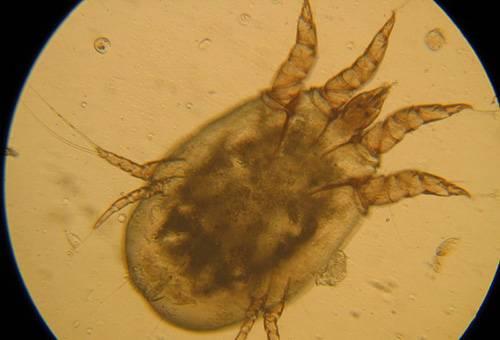
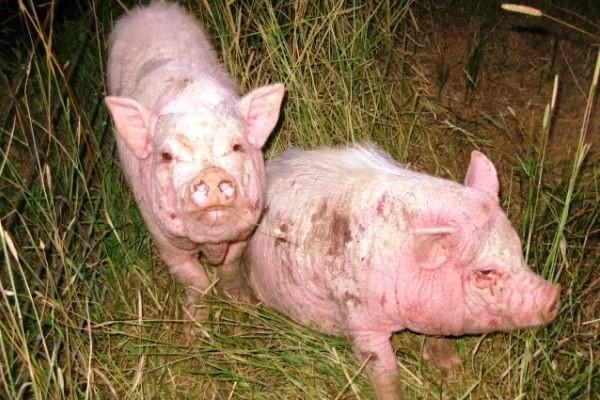
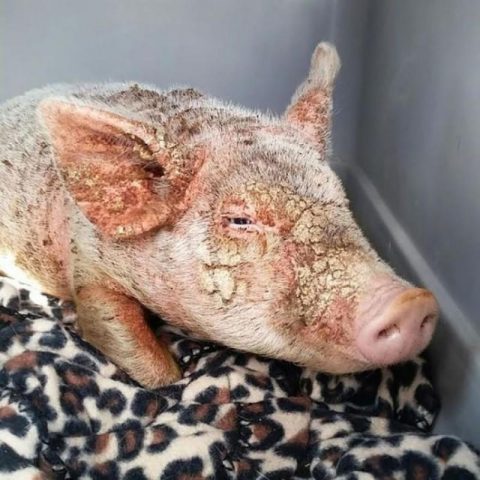
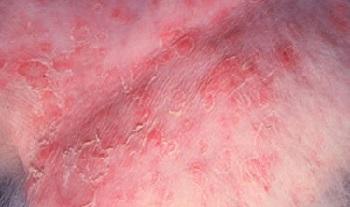
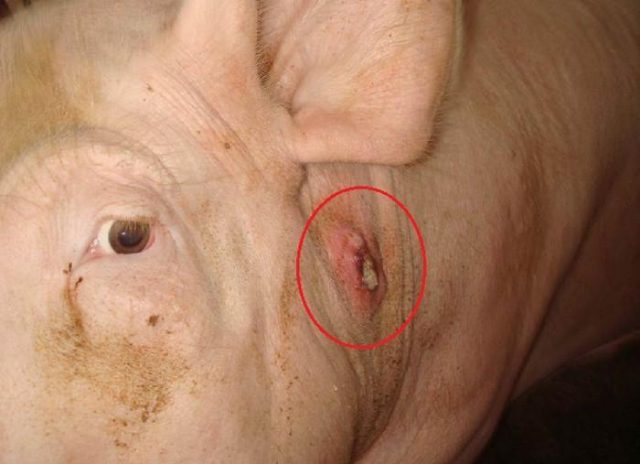








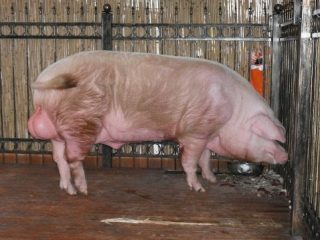


Pigs itch without a symptom of itching from scabies and worms itch for 2 months